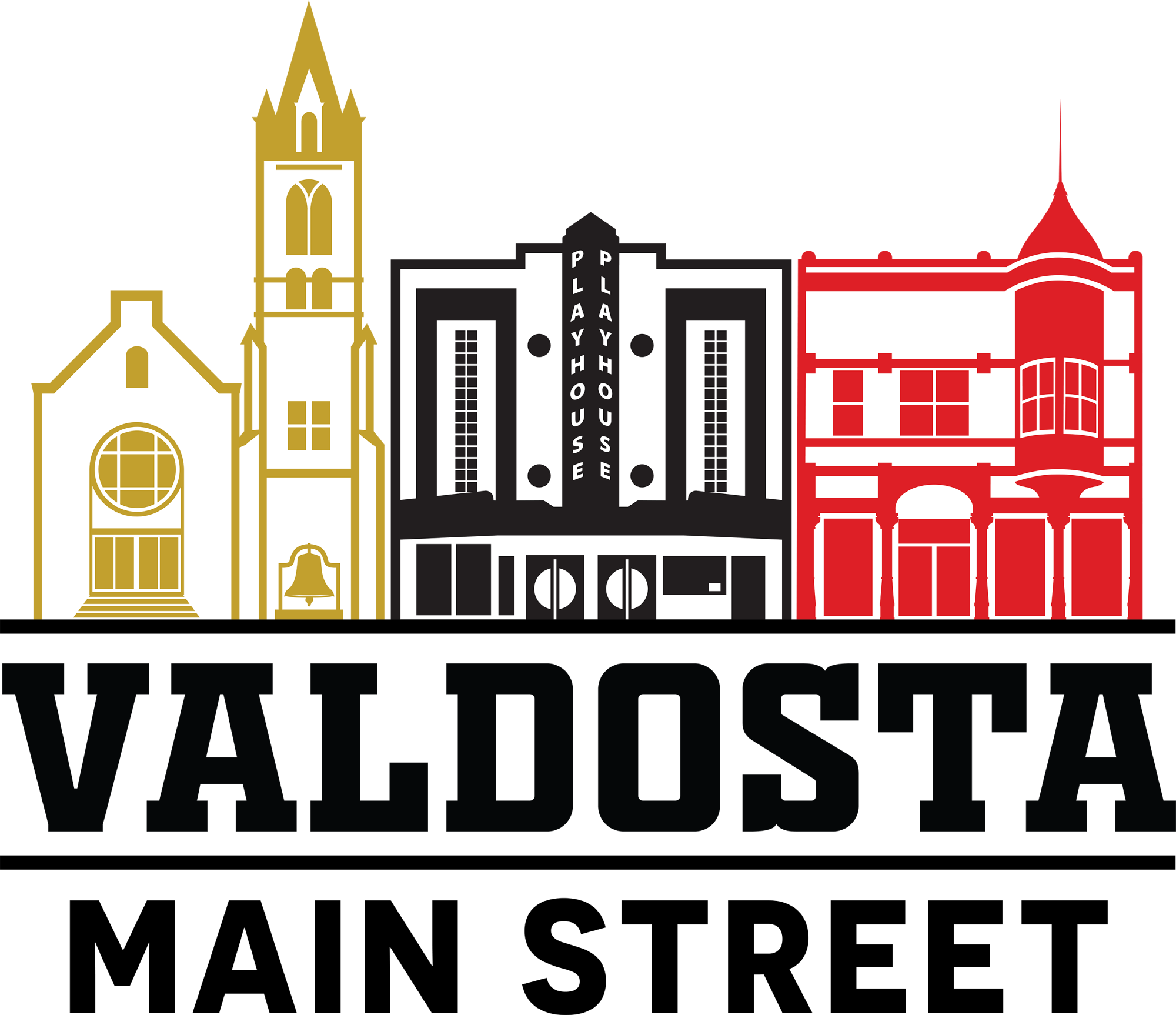About Us
Valdosta Main Street Branding Incentive
The Main Street Icon is representative of our history and vitality made up of three of our most recognized historic buildings. The goal is recognition from a memory, from long ago or recent, to connect people to Downtown Valdosta. If you have been here, you will remember those buildings. The brand icon showcases the First Methodist Church of Valdosta on Patterson Street, The Iconic Dosta Theatre on Ashley Street, and the Varnedoe Building (est. 1878 - clothing store) which was a contributing building of the created historic district and sits at the corner of Central Avenue and Patterson Street. This icon has become the recognized asset to identify the Main Street District, promotions and partnerships. It is front and center on our website, social media spaces, brochures and banners. We are proud to show off our history in our brand!
The Main Street Approach in Downtown Valdosta, GA
(Taken from The National Trust Main Street Center’s website)
What is the Main Street Approach to Commercial District Revitalization?
The Main Street Approach is a community-driven, comprehensive methodology used to revitalize older traditional business districts throughout the United States. It is a common-sense way to address the variety of issues and problems that face traditional business districts. The underlying premise of the Main Street approach is to encourage economic development within the context of historic preservation in ways appropriate to today’s marketplace. The Main Street Approach advocates a return to community self-reliance, local empowerment, and the rebuilding of traditional commercial districts based on their unique assets: distinctive architecture, a pedestrian-friendly environment, personal service, local ownership, and a sense of community.
The Main Street Four-Point Approach is a comprehensive strategy that is tailored to meet local needs and opportunities. It encompasses work in four distinct areas – Design, Economic Restructuring, Promotions, and Organization – that are combine to address all of the commercial district’s needs. The philosophy and the eight guiding principles behind this methodology make it an effective tool for community-based, grassroots revitalization efforts. The Main Street Approach has been successful in communities of all sizes, both rural and urban.
The Main Street Approach is incremental; it is not designed to produce immediate change. Because they often fail to address the underlying causes of commercial district decline, expensive improvements, such as pedestrian malls or sports arenas, do not always generate the desired economic results. In order to succeed, a long-term revitalization effort requires careful attention to every aspect of downtown – a process that takes time and requires leadership and local capacity building.
The Main Street Four-Point Approach to commercial district revitalization
The National Main Street Center offers a comprehensive commercial district revitalization strategy that has been widely successful in towns and cities nationwide. Described below are the four points of the Main Street approach which work together to build a sustainable and complete community revitalization effort.
- Organization involves getting everyone working toward the same goal and assembling the appropriate human and financial resources to implement a Main Street revitalization program. A governing board and standing committee make up the fundamental organizational structure of the volunteer-driven program. Volunteers are coordinated and supported by a paid program director as well. This structure not only divides the workload and clearly delineates responsibilities, but also builds consensus and cooperation among the various stakeholders.
- Promotions sells a positive image of the commercial district and encourages consumers and investors, to live, work, shop, play and invest in the Main Street district. By marketing a district’s unique characteristics to residents, investors business owners, and visitors, an effective promotional strategy forges a positive image through advertising, retail promotional activity, special events, and marketing campaigns carried out by local volunteers. These activities improve consumer and investor confidence in the district and encourage commercial activity and investment in the area.
- Design means getting Main Street into top physical shape. Capitalizing on its best assets – such as historic buildings and pedestrian-oriented streets – is just part of the story. An inviting atmosphere, created through attractive window displays, parking areas, building improvements, street furniture, signs, sidewalks, streetlights, and landscaping, conveys a positive visual message about the commercial district and what it has to offer. Design activities also include instilling good maintenance practices in the commercial district, enhancing the physical appearance of the commercial district by rehabilitating historic buildings, encouraging appropriate new construction, developing sensitive design management systems, and long-term planning.
Economic Restructuring strengthens a community’s existing economic assets while expanding and diversifying its economic base. The Main Street program helps sharpen the competitiveness of existing business owners and recruits compatible new businesses and new economic uses to build a commercial district that responds to today’s consumers’ needs. Converting unused or underused commercial space into economically productive property also helps boost the profitability of the district.
Coincidentally, the four points of the Main Street Approach correspond with the four forces of real estate value, which are social, political, physical and economic.
MISSION STATEMENT
VISION STATEMENT
ADOPT A BENCH PROGRAM
This program provides individuals with an opportunity to commemorate or honor family, friends or events in downtown Valdosta through the adoption and financial care of a downtown bench.
For more information: Adopt a Bench Program.
